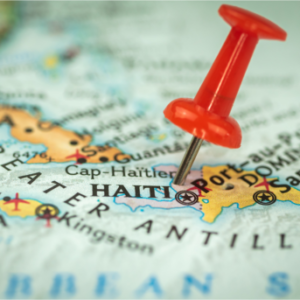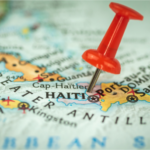France forces Haiti to pay an exorbitant debt in exchange for recognition of its independence. After the indIt ishanging, it is estimated that of the 425,000 slaves, only 170,000 remained to work on rebuilding the new country
220 years ago, Haiti became the first independent nation in Latin America, the oldest black republic in the world, and the second oldest republic in the Western Hemisphere after the United States.
These results follow the only successful slave revolt in human history. There is reason to be proud of a nation that has long been at the top of other, much more painful lists. Haiti is the poorest country in the Americas and one of the poorest in the world, according to all organizations that compile such rankings, including the World Bank and the International Monetary Fund.
The country, led by conzes and stateless people without spines for the most part, appointed by the international community, is currently mired in a massive political and social crisis, without a president since the assassination of President Jovenel Moïse in 2021, and with Prime Minister Ariel Henry forced to resign this week under pressure from armed gangs who control the capital, Port-au-Prince.
Haiti has been a victim of slavery, revolution, debt, deforestation, corruption, exploitation and violence. Not to mention colonization, American occupation, revolts, coups and dictatorships until the arrival in 1957 of François “Papa Doc” Duvalier, who imposed one of the most corrupt regimes and repressive forces of modern history, which lasted 28 years and caused numerous atrocities and embezzlement.
It is not surprising that neither infrastructure, nor education, nor health, nor any other public good has been a priority.
And this in a country that has the misfortune of being located on the main fault line between the North American and Caribbean tectonic plates and in the main path of the region’s hurricanes, making natural disasters even more disastrous.
In the midst of so many misfortunes, there is one that appears incongruous in the eyes of contemporaries: for having declared its independence, Haiti had to pay a heavy indemnity to the colonial power from which it freed itself..
From Ayiti to Hispaniola via Santo Domingo
Christopher Columbus arrived on the island that is now home to the republics of Haiti and the Dominican Republic in December 1492.
Assuming it was a territory of the Spanish crown, Christopher Columbus named the island Hispaniola or Hispaniola, met the natives, who were Tainos, called them “Indians” and spent his first Christmas with them in New World.
If the exploitation of gold deposits and the production of sugar initially excited the colonizers, the discovery of enormous riches on the American continent reduced interest in Hispaniola, in particular for the western part of the island.
The English, Dutch and French buccaneers fought over what the Tainos called Ayiti.
Those traveling under the flag of Louis XIV, the French “Sun King,” gradually took control of this corner of the island, and in 1665 France officially claimed it and named it Saint-Domingue.
Thirty years later, Madrid officially ceded a third of Hispaniola to Paris.
The pearl of the Antilles
The French made Santo Domingo one of the richest colonies in the world and the most lucrative in the Caribbean.
In 1789, 75% of the world’s sugar production came from Saint-Domingue, as did much of France’s wealth and glory.
The “Pearl of the Antilles” also produced coffee, tobacco, cocoa, cotton and indigo, and was the world leader in the production of each of these crops at one time or another during the 18th century. century.
The enormous wealth produced by the fabulous colony was obtained by importing tens of thousands of slaves per year and implementing a harsh system of slavery.
The Colored Revolution of Santo Domingo
Echoes of the French Revolution of 1789 reach the wealthy colony where “people of color” and slaves begin to question how the Declaration of the Rights of Man applies to their situation.
In 1791, a man of Jamaican origin, Boukman, became the leader of the African slaves on a large plantation in Cap-Français.
Modeled on the French Revolution, on August 22 of that year, slaves destroyed the plantations and executed all white people living in the region.
It was the first action of an uprising which turned into a civil war then a frontal battle against the forces of Napoleon Bonaparte, and which would take 12 years to achieve its objective: driving out the French.
On January 1, 1804, Haiti declared its independence and Jean-Jacques Dessalines became its first sovereign, first as governor general, then as Emperor Jacques I of Haiti, a title he gave himself.
Dessalines orders the killing of all white people.
Thus the Haiti massacre took place between early February and mid-April of that year, resulting in the deaths of 3,000 to 5,000 white men and women of all ages.
Not intending to hide what happened, Dessalines made an official statement: “We have returned these true cannibals war for war, crime for crime, indignation for indignation. Yes, I saved my country, I avenged America.”
The balance sheet
The long struggle for independence gave slaves autonomy, but it also destroyed much of the country’s plantations and infrastructure. The human cost is also enormous: it is estimated that of the 425,000 slaves, only 170,000 remained to work on rebuilding the new country.
Vengeance against the whitestaken after the capitulation of France, aroused the contempt of many nations. None recognizes Haiti diplomatically.
Furthermore, what happened in Santo Domingo was the worst nightmare of all the powers that had colonies in the neighborhood, and so they left Haiti in “quarantine” to avoid contagion.
This is how the unimaginable happened.
On April 17, 1825, Haitian President Jean-Pierre Boyer signed the royal ordinance of Charles.
A one-way street
The order promised Haiti diplomatic recognition from France in exchange for a 50% reduction in customs duties on French imports and compensation of 150 million francs (about $21 billion in today’s dollars). ), payable in five installments.
Why compensation?
Because the new country had to compensate French planters for the property they had lost, not only land but also slaves.
And if the Haitian government did not sign the agreement, the country would not only remain diplomatically isolated, but would be blocked by a flotilla of French warships already off the Haitian coast.
These 150 million gold francs are equivalent to the annual income of the Haitian government multiplied by 10. It is therefore not surprising that, when it comes to making the first payment, Haiti must borrow.
France sees no problem with this, provided that the loan is taken out from a French bank.
The debt of independence
This is how the so-called independence debt officially began.
A French bank lent Haiti 30 million francs – the amount of the first tranche due – and automatically deducted 6 million francs for commissions.
With what remained, i.e. 24 million francs, Haiti started paying reparations to Francethat is to say that the money went directly from the coffers of the French bank to the French Treasury.
At this very moment, Haiti owes 30 million francs to the French bank and 6 million francs more in total debt to France than before the first payment.
It is an endless spiral to repay a huge debt which, even halved in 1830, is too high for the Caribbean country.
He had to borrow considerable sums from American, French and German banks at exorbitant interest rateswhich forced it to devote most of its national budget to reimbursements.
Finally, in 1947, Haiti finished compensating the plantation owners of the French colony that was once the pearl of the Antilles. It took 122 years to repay the debt of independence.
source : BBC News Mundo






